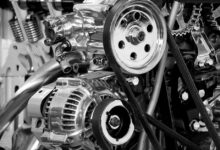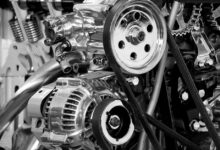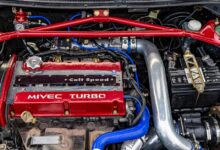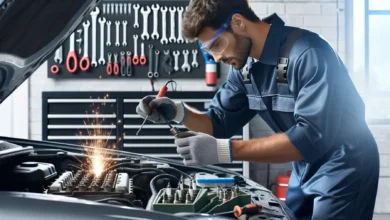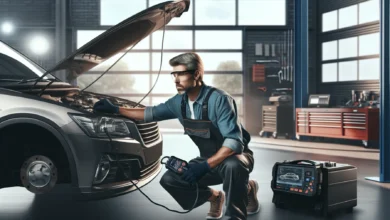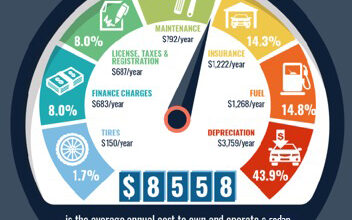Engine Air Filter Guide: Importance, Maintenance Tips & Replacement Steps for Better Car Performance
Sponsored Ads
When I think about keeping my car running smoothly, the engine air filter is always at the forefront of my mind. It’s a small part, but it plays a significant role in ensuring my engine breathes clean air and remains protected from dirt and debris. Failing to address this simple component can lead to more significant problems down the road.
I’ve learned that a clean engine air filter isn’t just about performance—it also improves fuel efficiency and extends the life of my vehicle. Since it’s often overlooked during routine maintenance, I want to share why paying attention to this filter can make a real difference for any car owner.
Why Engine Air Filters Are Important
Engine air filters regulate the flow of clean air into the engine, optimizing combustion. The filter traps impurities, including dust, sand, and pollen. If the engine lacks this protection, contaminants reduce performance and cause wear. Efficient air filtration lowers dirty air intake, directly improving engine efficiency and power.
Engine air filters also influence fuel economy. Clean filters support optimal fuel-to-air ratios, enabling engines to burn less fuel during operation and decreasing emissions. According to the US Department of Energy, replacing clogged filters on older vehicles increases acceleration by 6–11%.
Engine air filters extend engine longevity by blocking abrasive particles that can damage the engine. Contaminant-free air protects sensitive engine parts, such as cylinders and pistons, from damage. Premature engine failure becomes far less likely when filters remain well-maintained.
Engine air filters cost less to maintain than most engine repairs. Routine replacement or cleaning of the filter prevents expensive mechanical issues linked to unrestricted debris entering the engine. Air filter checks appear in recommended maintenance schedules for all passenger vehicles, including sedans, SUVs, and pickup trucks.
Engine air filters enhance overall vehicle performance—drivers may notice power surges, smoother acceleration, and cleaner exhaust when filters are in top condition. For vehicles in dusty or polluted environments, more frequent filter checks are essential.
Tools And Materials Needed
Replacing an engine air filter requires a short list of standard tools and materials. Using these simplifies the process and helps maintain precision.
- New engine air filter
I select the correct size and type for my vehicle using the owner’s manual or the manufacturer’s guide.
- Screwdriver or socket set
I use flathead or Phillips screwdrivers and the appropriate socket sizes to loosen and tighten the airbox fasteners.
- Shop rag or microfiber cloth
I wipe away dust and debris from the filter housing before inserting the new filter.
- Gloves
I wear disposable nitrile gloves for the clean handling of the replacement air filter and engine components.
- Vacuum (optional)
I remove accumulated dirt from the airbox using a handheld vacuum to ensure a cleaner installation, particularly when heavy debris is present.
These items ensure the engine air filter change is efficient and help protect both the vehicle and the new filter. Using the correct parts and tools directly supports optimal airflow, effective filtration, and ongoing engine protection in routine air filter maintenance.
Locating Your Engine Air Filter
I locate the engine air filter beneath the hood, usually close to the front or side of the engine bay. I know that knowing its exact position expedites routine maintenance and replacement.
Identifying The Air Filter Housing
I find the air filter housing described as a black or gray plastic box, often secured with metal clips, screws, or bolts. This housing sits on top of or beside the engine and connects to a large hose leading to the throttle body or intake manifold. For rectangular housings, I look above the engine (example: Toyota Camry); for cylindrical housings, I check the sides near the fender (example: Ford F-150). Labels or intake symbols sometimes mark the housing for easy recognition.
Tips For Different Vehicle Models
I reference the owner’s manual to confirm the location of my specific air filter. For sedans, I notice that air filter boxes are typically placed near the front of the engine (examples: Honda Accord, Hyundai Sonata). For trucks and SUVs, I scan the fender wells or sides for round canister-style housings (examples include the Chevrolet Silverado and Jeep Grand Cherokee). European and performance models sometimes position the air filter deeper, beneath covers or panels, requiring extra steps for access. Consistently, I check for obvious latches and intake duct connections to help pinpoint the filter housing in all vehicle makes and models.
How To Remove The Old Engine Air Filter
Removing the old engine air filter clears clogged debris and ensures unimpeded airflow for the engine. I follow a precise process to prevent contamination or damage during filter removal.
Steps For Safe Removal
- Disconnect the battery terminals when the airbox is positioned close to sensitive electrical systems.
- Unclip or unscrew the air filter housing carefully, using a flathead screwdriver or socket set if metal screws secure the assembly.
- Lift the airbox cover, then gently tilt or remove it to prevent particles from falling inside.
- Pull the old engine air filter out by the rigid frame or handle, avoiding distortion of the filter shape.
- Inspect the air filter box for dust, leaves, or debris, and empty or vacuum it as needed.
- Wipe the inner housing with a clean microfiber cloth to reduce residual contamination.
Precautions To Avoid Engine Damage
- Prevent foreign objects from dropping into the intake tract by covering exposed openings with a clean shop rag.
- Avoid using excessive force on fragile plastic clips or housings to lower the risk of cracks or damage.
- Keep engine air filter materials away from wet or oily surfaces, as moisture or oil can compromise future filtration.
- Confirm that no old gasket, seal, or debris remains inside the airbox before installing a new filter to maintain proper sealing and airflow.
- Handle the filter element and internal engine compartments with clean gloves to minimize the risk of transferring dirt.
Inspecting The Old Filter
Engine air filter inspection confirms airflow quality and engine protection. I check the old filter for contaminants and structural damage before installing a new one.
Signs Your Filter Needs Replacement
I look for these key indicators:
- Visible dirt and discoloration: Dark brown or black areas or patchy deposits signal trapped dust and debris.
- Warped or torn filter material: Torn edges or deformed pleats reduce filtration effectiveness, allowing contaminants to reach the engine.
- Unusual engine behavior: Decreased acceleration or rough idling may result from restricted airflow.
- Check engine light: Illuminated lights on the dashboard sometimes indicate airflow sensor issues related to a clogged filter.
Observing one or more of these conditions confirms the requirement for immediate replacement.
How Often Should You Replace An Engine Air Filter?
I consult vehicle manufacturer guidelines for air filter replacement intervals. For most US passenger vehicles under regular conditions, 12,000 to 15,000 miles or 12 months aligns with industry recommendations (source: CarCare.org). For vehicles operating in dusty climates or high-traffic urban areas, every 6,000 to 10,000 miles minimizes performance loss and contamination risk.
| Driving Condition | Recommended Interval |
|---|---|
| Standard (city/highway mix) | 12,000–15,000 miles |
| Dusty/off-road environments | 6,000–10,000 miles |
| Manufacturer’s maintenance | Refer to the owner’s manual |
My adherence to these intervals ensures peak engine performance and long-term protection.
Installing The New Engine Air Filter
Replacing the engine air filter maintains optimal engine performance and filtration efficiency. Focusing on precise filter placement and a secure seal protects the engine from airborne contaminants.
Correct Placement Techniques
Placing the new engine air filter correctly ensures that clean air flows efficiently into the engine. I align the new filter with the orientation marks or tabs on the filter housing, ensuring the shape and size match those of the old filter. I gently lower the filter into the airbox, confirming the filter media faces the airflow path, which typically means the rubber or plastic rim sits flush against the housing edge. I avoid bending or forcing the element, as misalignment creates air gaps that allow impurities to enter. If the airbox design includes a gasket or slot, I check all corners for complete contact to prevent edge lift. Proper positioning supports even airflow and maximizes filtration efficiency throughout the filter’s service life.
Ensuring A Proper Seal
Ensuring a proper seal prevents unfiltered air from bypassing the engine air filter. I press the air filter firmly into the housing gasket or frame, verifying that every edge sits flat against its seat. I inspect the area around the sealing surface for debris and clean the rim or groove with a microfiber cloth before assembly, if necessary. I reattach the airbox cover, fastening all clips, screws, or latches in the original order to apply even pressure along the seal. I double-check for movement by pressing around the airbox edge. Secure fitment preserves the sealed barrier, maintaining the integrity of the engine’s intake system and supporting sustained performance.
Alternative Methods And Tips
Multiple approaches help keep my engine air filter functioning efficiently and extend the engine’s lifespan. Specific methods and filter types yield varying results depending on the driving environment and vehicle requirements.
Cleaning vs. Replacing: What’s Better?
Cleaning a reusable engine air filter supports cost savings and environmental benefits, particularly when the filter is made from synthetic or cotton material (examples: K&N or aFe brands). I tap out loose debris, gently vacuum the surface, and use manufacturer-approved cleaning kits before thoroughly drying the filter. Cleaning washable filters proves effective at intervals of approximately every 10,000 to 15,000 miles, as indicated by visible dirt buildup.
Replacing a disposable paper engine air filter provides guaranteed efficiency and protection, especially in severe conditions (such as dusty roads or heavy traffic areas). I inspect for discoloration, damage, or clogging and install a new OEM or aftermarket filter if buildup or restricted airflow appears. Replacement delivers maximum filtration on vehicles using single-use filters, maximizing performance and fuel economy for up to 12,000 to 15,000 miles under regular use, or more frequently if severe dust is encountered.
Choosing The Right Engine Air Filter For Your Vehicle
Selecting a compatible engine air filter safeguards optimal engine performance and fit (examples: direct OEM replacement, high-flow aftermarket, or performance washable types). I use my owner’s manual or reputable online databases to match filter specifications, ensuring that the dimensions, style, and material align with the manufacturer’s recommendations. For standard city or highway commuting, I prefer OEM or high-quality aftermarket paper filters to maintain longevity and warranty compliance. When I drive in dusty environments or seek increased airflow, I consider performance washable filters made from cotton gauze or synthetic blends that support cleaning and reuse. I avoid using ill-fitting or unapproved filters, as these options can allow unfiltered air to enter, undermining engine protection and efficiency.
Troubleshooting Common Engine Air Filter Issues
Engine air filter maintenance sometimes reveals fitment problems and warning lights after a new filter installation. I address these specific issues with clear steps for corrective action.
Filter Won’t Fit Properly
Improper engine air filter fitment often occurs when the wrong size or shape is ordered for a specific vehicle model. I confirm the part number with the owner’s manual or the original filter before installation; for example, the Honda Accord uses different filters than the Toyota Camry models. I inspect the filter orientation to ensure the rubber sealing edge and pleated side match the contours of the filter box. I avoid forcing the filter if resistance occurs, as deformation or damage becomes likely. I recheck packaging labels and consult online parts diagrams for cross-reference if fitment persists as an issue. I return mismatched filters and obtain the precise replacement for my year, make, and model to guarantee a proper seal and optimal airflow.
Engine Warning Lights After Replacement
Engine warning lights sometimes illuminate after an engine air filter change, often signaling a dislodged intake sensor or an improperly sealed airbox. I verify that all sensor connections around the air filter housing remain intact, as mass airflow sensors are frequently disturbed in Ford F-150 and Chevrolet Silverado trucks. I inspect the air filter seal, ensuring the housing closes tightly with no visible air gaps or pinched filter elements. I reset the warning light by disconnecting the vehicle’s battery for several minutes, as some modern vehicles, such as the Hyundai Sonata or Subaru Forester, clear diagnostic codes with a power cycle. I want to undergo a diagnostic scan if the warning light persists, with a focus on airflow sensor or intake system codes that indicate an installation or compatibility issue with the replacement filter.
Maintaining Your Engine Air Filter For Longevity
Consistent maintenance extends the lifespan of the engine air filter and preserves optimal engine performance. Monitoring usage patterns and environmental factors ensures the engine receives clean air and maximum protection year-round.
Regular Inspection Schedule
Maintaining a regular engine air filter inspection schedule allows for early detection of buildup and damage.
- Monthly quick checks help catch severe dirt or debris between recommended intervals.
- At every oil change—usually every 5,000 miles—I inspect the filter for excess dust or discoloration.
- During seasonal changes, especially after harsh weather or pollen-heavy months, extra inspections spot early signs of clogging.
- Using a permanent marker, I record the inspection date on the air filter housing for accurate tracking.
Following these intervals, I adhere to manufacturer recommendations while adjusting to specific usage patterns.
Driving Conditions That Affect Filter Life
Driving conditions significantly impact the frequency of engine air filter replacement.
- Dusty roadways or construction areas, such as unpaved gravel streets or active job sites, rapidly saturate filters with larger debris and dust.
- Urban highways with high traffic and frequent stop-and-go movement expose filters to pollution and particulates from vehicle emissions.
- Rural or agricultural routes present increased quantities of pollen and plant fragments, which accelerate clogging.
- Humid climates encourage moisture retention in filter media, sometimes leading to faster deterioration.
For example, operating a vehicle in Arizona requires an inspection every 6,000 to 10,000 miles, while suburban driving in New York allows for standard intervals of 12,000 to 15,000 miles. Adjusting maintenance frequency based on real-world driving environments preserves both filter and engine longevity.
Conclusion
Taking care of my engine air filter is a simple step that pays off in so many ways. I’ve found that staying proactive with checks and replacements saves me from bigger headaches down the road. It’s easy to overlook this small part, but its impact on performance and efficiency is enormous.
By making air filter maintenance a habit, I’m investing in my car’s health and my peace of mind. If you haven’t checked your filter lately, now’s the perfect time to make it part of your routine.
Frequently Asked Questions
What does an engine air filter do?
An engine air filter cleans the air entering your engine by trapping dust, dirt, and debris. This ensures that only clean air mixes with fuel for combustion, helping your engine run efficiently and protecting it from damage.
How often should I change my engine air filter?
Most experts recommend changing your engine air filter every 12,000 to 15,000 miles, or at least once a year. If you drive in dusty or polluted areas, replace it every 6,000 to 10,000 miles for best results. Always consult your owner’s manual for specific recommendations.
What are the signs that my engine air filter needs to be replaced?
Common signs include reduced acceleration, poor fuel economy, unusual engine sounds, a visibly dirty or discolored filter, decreased engine performance, and a check engine light. Regular inspections can help catch problems early.
Can a dirty air filter affect my car’s performance?
Yes, a dirty or clogged air filter restricts airflow to the engine, which can reduce engine power, lower fuel efficiency, cause rough idling, and increase emissions. Replacing a dirty filter can noticeably improve overall performance.
Where is the engine air filter usually located?
The air filter is typically housed in a black or gray plastic box near the front or side of the engine bay. Refer to your owner’s manual for the exact location, as it may vary depending on your car’s make and model.
What tools are needed to replace my engine air filter?
Basic tools include a screwdriver or socket set to open the airbox, a shop rag or microfiber cloth to clean the housing, disposable gloves, and possibly a small vacuum for debris. Always use the correct size air filter matched to your vehicle.
Can I clean and reuse my engine air filter?
Some engine air filters, especially those made from synthetic or cotton materials, are reusable and can be cleaned for reuse. However, paper filters should be replaced and not cleaned. Check your filter type and manufacturer recommendations.
What happens if I install the wrong air filter?
Installing an ill-fitting or incorrect air filter can allow unfiltered air to enter the engine, resulting in reduced performance, increased engine wear, and potential sensor errors or warning lights. Always ensure the filter matches your vehicle’s specifications.
Are there benefits to using high-performance or washable filters?
High-performance or washable filters can provide better airflow and filtration, especially in dusty or challenging driving conditions. While washable filters can be reused after cleaning, they may require more maintenance than standard filters.
How often should I inspect my engine air filter?
Inspect your engine air filter at least once a month, during every oil change, or when driving conditions become harsh (dust, pollution, or extreme humidity). Regular checks help maintain peak performance and protect the engine.


